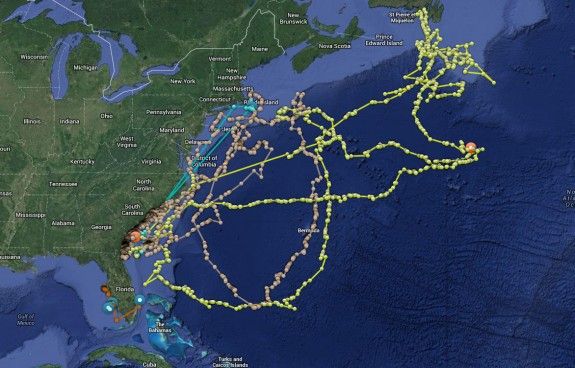Great White Sharks Swim Up, Down, Far, Wide—All Over the Place, Really—And We Had No Idea
Satellite tags map great white shark movements
/https://tf-cmsv2-smithsonianmag-media.s3.amazonaws.com/filer/31/7b/317b383e-6708-42a3-b6a3-7f03afc4a7f6/great-white-sharks-swim-1024-646.jpg)
For decades researchers have been using satellite tags to track Great White sharks as they swim about the Pacific Ocean, and, in recent years, similar campaigns have begun to chart the travels of the sharks who inhabit the waters of the Atlantic Ocean. Tagged by the non-profit organization Ocearch, real-time monitoring tags, which use GPS signals, upload to Ocearch's Shark Tracker, where you can watch Great Whites swim around the Atlantic Ocean, and off the coast of Africa.
Writing for Wired magazine, Peter Brannen describes how researchers are using these shark tags to try to figure out the “secret lives of great white sharks.” But rather than unlocking any real insights, says Brannen, what the tags have really done is shown us just how little we know about the behavior of these mighty fish.
The data transmitted from these two sharks in the past year has been a revelation. Skomal and Thorrold are looking for patterns that might reveal something about the animals’ lifestyle.… The researchers are searching for recurring tracks and well-trod patches of ocean that might illuminate important nurseries, breeding or feeding grounds, information that could lead to eventual conservation measures. But so far the data has been frustratingly — even thrillingly — erratic.
“There’s no frickin’ pattern at all,” Skomal said.

Shark scientists have developed ideas about where sharks should be and when, as they follow changing temperatures, or booms in different feeding grounds. In fact, it's the abundance of seals on the islands off Cape Cod, says Brannen, that brought enough Great Whites to one place to let the researchers do their tagging. But even these best guesses on how the sharks should behave are being undone by the new tag data.
Conventional wisdom held that the sharks would hunt seals off of Cape Cod in the summer and then head to Florida in the winter. “We expected them to do the snowbird thing,” said Thorrold. Well, it’s December and Mary Lee has, in fact, returned to Florida, but Lydia isn’t following that script. Her most recent flurry of pings has come from just off of Newfoundland, 1,000 miles away, in water just a few degrees above freezing.
“What on earth is she doing there?” Thorrold said, laughing at the strangeness of it.
Great White sharks are an apex predator, the top of the the ocean food chain, and yet we still really have no idea what they're up to.
More from Smithsonian.com:
Track Your Very Own Great White
Great White Sharks Are Being Killed Before They Can Become Truly Gigantic
/https://tf-cmsv2-smithsonianmag-media.s3.amazonaws.com/accounts/headshot/smartnews-colin-schultz-240.jpg)
/https://tf-cmsv2-smithsonianmag-media.s3.amazonaws.com/accounts/headshot/smartnews-colin-schultz-240.jpg)